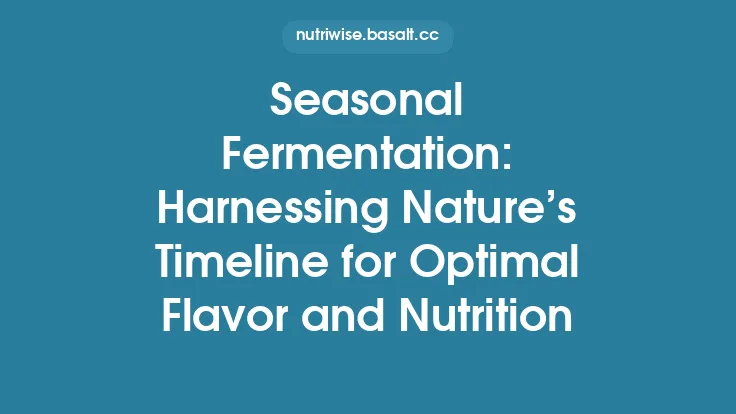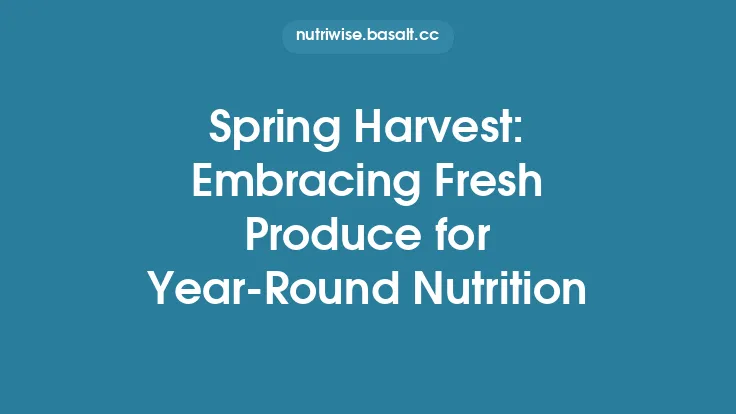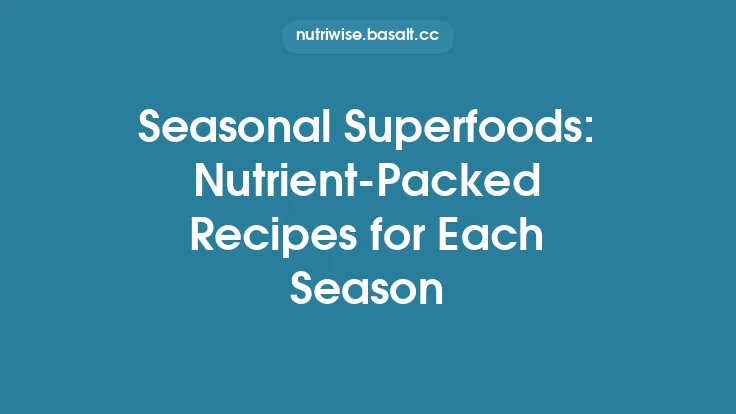Summer is the season when the grill becomes the centerpiece of the backyard, the patio, or even the balcony. The long days, warm evenings, and abundant harvest of fresh fruits and vegetables create the perfect backdrop for meals that are both delicious and nutritionally robust. This guide walks you through the science of grilling summer produce, offers practical tips for selecting and preparing the best ingredients, and provides a collection of nutrient‑dense recipes that can be adapted to a variety of dietary preferences. Whether you’re a seasoned pitmaster or a casual weekend griller, the information here will help you maximize flavor, preserve micronutrients, and build balanced meals that support optimal health throughout the summer months.
Why Summer Is Ideal for Grilling
- Peak Freshness: Summer crops such as tomatoes, corn, zucchini, bell peppers, stone fruits, and leafy greens reach their peak flavor and nutrient density during the warm months. Harvesting at peak ripeness means higher concentrations of vitamins (A, C, K), antioxidants (lycopene, beta‑carotene, flavonoids), and phytonutrients.
- Heat‑Induced Flavor Development: The high heat of a grill triggers the Maillard reaction and caramelization, creating complex flavor compounds that enhance the natural sweetness of summer produce. These reactions also produce modest amounts of heterocyclic amines (HCAs) and polycyclic aromatic hydrocarbons (PAHs); however, proper grilling techniques (e.g., avoiding charring, using indirect heat) keep these compounds at safe levels.
- Convenient Cooking: Grilling is a quick, one‑pan method that preserves the water‑soluble vitamins (especially vitamin C) better than boiling, which can leach nutrients into cooking water.
Nutrient Profile of Key Summer Produce
| Produce | Primary Vitamins & Minerals | Notable Phytonutrients | Typical Serving (raw) |
|---|---|---|---|
| Tomatoes | Vitamin C, K, potassium | Lycopene, beta‑carotene | 1 cup (≈150 g) |
| Sweet corn | Folate, thiamine, magnesium | Lutein, zeaxanthin | 1 ear (≈90 g) |
| Zucchini | Vitamin A, C, manganese | Lutein, zeaxanthin | 1 medium (≈200 g) |
| Bell peppers (red) | Vitamin C, A, B6 | Capsanthin, quercetin | ½ cup sliced (≈75 g) |
| Peaches | Vitamin A, C, potassium | Chlorogenic acid | 1 medium (≈150 g) |
| Watermelon | Vitamin A, C, potassium | Lycopene, citrulline | 2 cups diced (≈300 g) |
| Eggplant | Vitamin B1, B6, potassium | Nasunin (anthocyanin) | ½ cup cubed (≈75 g) |
| Fresh herbs (basil, mint) | Vitamin K, A | Essential oils (e.g., eugenol) | 1 tbsp chopped |
Grilling can slightly concentrate these nutrients by reducing water content, but it’s essential to avoid overcooking, which can degrade heat‑sensitive vitamins (especially vitamin C). A quick sear (2–4 minutes per side) is often sufficient to achieve flavor while preserving nutrition.
Choosing the Right Grill and Tools
- Fuel Type
- *Charcoal*: Imparts smoky flavor and higher temperatures (up to 650 °F). Use natural lump charcoal to avoid additives.
- *Propane/Natural Gas*: Offers precise temperature control and cleaner burn, reducing PAH formation.
- *Hybrid*: Some grills combine gas burners with a charcoal tray for flexibility.
- Temperature Zones
- Direct Heat (high, 450–550 °F): Ideal for quick‑cooking items like shrimp, thin vegetable slices, and fruit halves.
- Indirect Heat (medium, 300–350 °F): Best for larger pieces such as chicken breasts, fish fillets, or whole vegetables that need thorough cooking without burning.
- Essential Tools
- Heavy‑duty stainless‑steel tongs (avoid piercing to retain juices).
- A wide, flat grill basket for small items (e.g., cherry tomatoes, sliced zucchini).
- A cast‑iron grill pan for delicate produce that might slip through grates.
- A meat thermometer (instant‑read) to ensure safe internal temperatures (e.g., 165 °F for poultry, 145 °F for fish).
Selecting Seasonal Produce for the Grill
- Firm Fruits: Peaches, plums, pineapples, and watermelon rind hold up well on the grill and develop caramelized sugars.
- Starchy Vegetables: Corn on the cob, sweet potatoes, and baby potatoes benefit from a brief pre‑boil or microwave “par‑cook” to reduce grill time.
- Leafy Greens: Romaine hearts, kale, and collard greens can be lightly brushed with oil and grilled for 2–3 minutes per side, creating a smoky “chip” texture.
- Protein‑Rich Plant Foods: Halloumi, firm tofu, and tempeh have high melting points, making them suitable for high‑heat searing without disintegrating.
Balancing Macronutrients on the Grill
A nutritionally balanced grilled plate typically includes:
- Protein (20–30 % of calories): Grilled chicken, fish, lean pork, or plant‑based options like tempeh.
- Complex Carbohydrates (40–50 % of calories): Grilled corn, sweet potatoes, or quinoa salads served alongside.
- Healthy Fats (20–30 % of calories): Olive oil drizzles, avocado slices, or nuts incorporated into side salads.
By pairing a lean protein with fiber‑rich vegetables and a modest amount of healthy fat, you achieve satiety, stable blood glucose, and a broad spectrum of micronutrients.
Recipe 1 – Grilled Peach and Halloumi Salad
Yield: 4 servings
Macronutrient Balance: ~35 g protein, 30 g carbs, 18 g fat per serving
Ingredients
- 4 ripe peaches, halved and pitted
- 8 oz (≈225 g) halloumi cheese, sliced ½‑inch thick
- 4 cups mixed baby greens (arugula, spinach, watercress)
- ¼ cup toasted pistachios, coarsely chopped
- 2 tbsp extra‑virgin olive oil
- 1 tbsp balsamic reduction
- Fresh mint leaves, torn (optional)
- Salt & pepper to taste
Method
- Preheat grill to medium‑high (≈425 °F).
- Brush peach halves and halloumi slices lightly with olive oil; season with a pinch of salt.
- Grill peaches cut‑side down for 2–3 minutes until grill marks appear; flip and grill for another minute.
- Grill halloumi for 1–2 minutes per side until golden.
- In a large bowl, toss greens with a drizzle of olive oil and a pinch of salt.
- Arrange grilled peaches and halloumi atop the greens, sprinkle pistachios and mint, and finish with balsamic reduction.
Nutritional Highlights
- Peaches provide vitamin A, C, and potassium.
- Halloumi supplies high‑quality casein protein and calcium.
- Pistachios add monounsaturated fats and vitamin B6.
Recipe 2 – Charred Corn and Black Bean Salsa
Yield: 6 servings (as a side or topping)
Macronutrient Balance: ~8 g protein, 35 g carbs, 4 g fat per serving
Ingredients
- 6 ears of fresh sweet corn, husks removed
- 1 ½ cups cooked black beans (or canned, rinsed)
- 1 red bell pepper, diced
- ½ red onion, finely chopped
- 1 jalapeño, seeded and minced (optional)
- ¼ cup fresh cilantro, chopped
- Juice of 2 limes
- 1 tbsp olive oil
- ½ tsp smoked paprika
- Salt & pepper to taste
Method
- Heat grill to high (≈500 °F). Grill corn directly on the grates, turning every 2 minutes, until kernels are blistered (≈8–10 minutes).
- Remove corn, let cool slightly, then cut kernels off the cob onto a cutting board.
- In a mixing bowl, combine charred corn kernels, black beans, bell pepper, onion, jalapeño, and cilantro.
- Dress with lime juice, olive oil, smoked paprika, salt, and pepper. Toss gently.
Nutritional Highlights
- Corn offers fiber, folate, and lutein.
- Black beans contribute plant‑based protein, iron, and resistant starch.
- Lime juice adds vitamin C, enhancing iron absorption from beans.
Recipe 3 – Lemon‑Herb Grilled Chicken with Zucchini
Yield: 4 servings
Macronutrient Balance: ~40 g protein, 10 g carbs, 12 g fat per serving
Ingredients
- 4 skinless, boneless chicken breasts (≈150 g each)
- 2 tbsp fresh lemon zest
- 3 tbsp freshly squeezed lemon juice
- 2 tbsp chopped fresh rosemary
- 2 tbsp chopped fresh thyme
- 2 tbsp olive oil
- 2 medium zucchinis, sliced lengthwise (¼‑inch thick)
- 2 tbsp grated Parmesan (optional)
- Salt & pepper
Method
- In a shallow dish, whisk lemon zest, juice, herbs, olive oil, salt, and pepper. Add chicken breasts, turning to coat; marinate 15 minutes (or up to 2 hours in the refrigerator).
- Preheat grill to medium (≈375 °F).
- Grill chicken 6–7 minutes per side, or until internal temperature reaches 165 °F.
- While chicken cooks, brush zucchini slices with a little olive oil, season, and grill 2–3 minutes per side until tender‑crisp.
- Slice chicken, arrange over grilled zucchini, and sprinkle with Parmesan if desired.
Nutritional Highlights
- Chicken provides lean, complete protein and B‑vitamins.
- Zucchini contributes vitamin A, C, and potassium with minimal calories.
- Lemon adds vitamin C, which aids in collagen synthesis and iron absorption.
Recipe 4 – Grilled Salmon with Mango‑Cilantro Salsa
Yield: 4 servings
Macronutrient Balance: ~30 g protein, 12 g carbs, 18 g fat per serving (rich in omega‑3)
Ingredients
- 4 salmon fillets (≈170 g each), skin on
- 1 tbsp olive oil
- Salt & pepper
- 1 ripe mango, diced
- ¼ cup red onion, finely chopped
- ¼ cup fresh cilantro, chopped
- 1 tbsp lime juice
- ½ tsp ground cumin
- 1 small jalapeño, minced (optional)
Method
- Brush salmon fillets with olive oil, season with salt and pepper.
- Preheat grill to medium‑high (≈425 °F). Place salmon skin‑side down; grill 4–5 minutes, then flip and grill another 3–4 minutes, or until internal temperature reaches 145 °F.
- While salmon cooks, combine mango, red onion, cilantro, lime juice, cumin, and jalapeño in a bowl; season lightly with salt.
- Serve each salmon fillet topped with a generous spoonful of mango salsa.
Nutritional Highlights
- Salmon is a premier source of EPA/DHA omega‑3 fatty acids, supporting cardiovascular and brain health.
- Mango supplies vitamin A (beta‑carotene) and vitamin C, while the salsa’s acidity helps preserve the delicate omega‑3s during cooking.
Recipe 5 – Veggie Skewers with Quinoa Tabbouleh
Yield: 6 servings (2 skewers per person)
Macronutrient Balance: ~12 g protein, 45 g carbs, 9 g fat per serving
Ingredients – Skewers
- 1 red bell pepper, cut into 1‑inch squares
- 1 yellow bell pepper, cut into 1‑inch squares
- 1 small red onion, quartered
- 1 cup button mushrooms, stems removed
- 1 small eggplant, cubed 1‑inch
- 2 tbsp olive oil
- 1 tsp dried oregano
- Salt & pepper
Ingredients – Quinoa Tabbouleh
- 1 cup quinoa, rinsed
- 2 cups water or low‑sodium vegetable broth
- ½ cup fresh parsley, finely chopped
- ¼ cup fresh mint, finely chopped
- 1 cucumber, seeded and diced
- 2 tbsp lemon juice
- 1 tbsp olive oil
- Salt & pepper
Method
- Quinoa: Bring water/broth to boil, add quinoa, reduce to simmer, cover, and cook 15 minutes. Fluff with fork, let cool.
- Tabbouleh: In a large bowl, combine cooled quinoa, parsley, mint, cucumber, lemon juice, olive oil, salt, and pepper. Mix gently.
- Skewers: Thread vegetables onto metal or soaked wooden skewers, alternating colors for visual appeal. Brush with olive oil, sprinkle oregano, salt, and pepper.
- Preheat grill to medium (≈350 °F). Grill skewers 8–10 minutes, turning every 2 minutes, until vegetables are tender‑crisp and lightly charred.
- Serve skewers alongside a generous portion of quinoa tabbouleh.
Nutritional Highlights
- Quinoa provides complete plant protein, magnesium, and fiber.
- Eggplant and peppers deliver antioxidants such as nasunin and capsanthin.
- Herbs add phytonutrients and enhance digestion.
Food Safety and Grill Hygiene
- Pre‑heat the grill for at least 10 minutes before cooking to kill surface bacteria.
- Separate raw proteins from ready‑to‑eat produce using different grill zones or separate grill pans.
- Use a food‑grade thermometer to verify internal temperatures: 165 °F for poultry, 145 °F for fish, 160 °F for ground meats.
- Clean grates after each session with a stiff wire brush while still warm; a light spray of food‑safe oil can prevent rust and reduce sticking.
- Store leftovers promptly (within 2 hours) in shallow containers and refrigerate at ≤40 °F. Reheat to at least 165 °F before consumption.
Storing Leftovers and Meal‑Prep Tips
- Portion Control: Divide grilled proteins and vegetables into 4‑oz (protein) and 1‑cup (vegetable) containers for easy grab‑and‑go meals.
- Re‑heat Safely: Use a stovetop skillet with a splash of broth or a microwave‑safe cover to retain moisture and prevent drying.
- Cold‑Meal Options: Many of the recipes (e.g., quinoa tabbouleh, corn salsa) taste excellent chilled, making them perfect for salads or sandwich fillings.
4 Batch‑Cook Corn: Grill a full rack of corn, freeze kernels in airtight bags, and thaw as needed for quick side dishes or soups.
Integrating Grilled Meals into a Balanced Summer Meal Plan
- Breakfast: Overnight quinoa with grilled pineapple, Greek yogurt, and a drizzle of honey.
- Lunch: Grilled chicken and zucchini wrap with whole‑grain tortilla, paired with a side of charred corn salsa.
- Snack: Grilled peach slices topped with a dollop of ricotta and a sprinkle of cinnamon.
- Dinner: One of the featured main‑course recipes (salmon, halloumi salad, or veggie skewers) accompanied by a mixed green salad dressed with lemon‑olive oil vinaigrette.
- Hydration: Pair meals with infused water (cucumber‑mint, citrus‑berry) to replace electrolytes lost through summer heat.
By rotating these dishes throughout the week, you ensure a variety of micronutrients, maintain protein adequacy, and keep carbohydrate sources primarily from fiber‑rich vegetables and whole grains—key factors for sustained energy and optimal health during the active summer months.
Final Thoughts
Grilling isn’t just a cooking method; it’s a seasonal strategy that leverages the natural abundance of summer produce to deliver meals that are flavorful, nutrient‑dense, and socially engaging. Understanding the science behind heat‑induced flavor development, selecting the right tools, and applying balanced nutrition principles empowers you to create dishes that satisfy both the palate and the body. Keep the grill hot, the ingredients fresh, and the portion sizes mindful, and you’ll enjoy a summer of vibrant, health‑supporting meals that keep you energized from sunrise barbecues to twilight gatherings.





